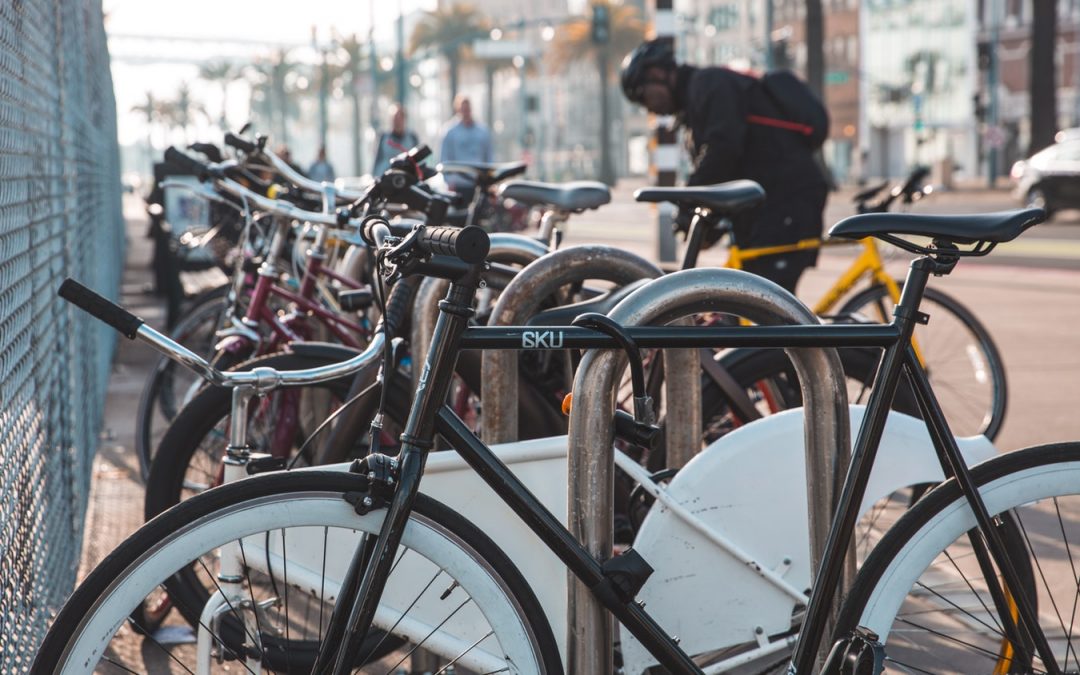Theft Prevention
Location, location: We’d all love to lock up in secured indoor bike facilities, but this is rarely an option (though it doesn’t hurt to explore this idea at work with human resources or the wellness committee!). Downtown workers will appreciate the many parkades that offer bike racks or cages—Just be sure to still to lock it properly, even when the cage appears secure! The next best thing is to attach your bike to a fixed object with lots of foot traffic nearby. Just keep in mind that many signposts in Winnipeg are bolted into a collar that sits in the concrete. The whole post can be removed simply by loosening a bolt. A better option is to use a designated bike rack that would be heavy to carry, or is cemented into the ground.
The right lock. A number of manufacturers have a no-theft guarantee that will reimburse you in case your bike is stolen due to the lock being broken or cut. Just make sure you register with them! Make sure your U-Lock is big enough; smaller locks are lighter, but depending on your bike, may prevent you from locking a wheel and frame with a single lock. Avoid older locks with cylindrical keys, which are easy to open with a ballpoint pen casing. Some people will elect for a second lock, often a thick cable, to secure their front wheel, which is especially important if it has a quick-releases. If you have to only lock one wheel, the rear is typically much more expensive than the front.
Locking technique: How you lock the bike will depend on the style of bike, and what you are locking it to. Many bikes are sold with quick-release skewers on the front and rear wheels, which allows for adjustment or removal without tools, but also invites opportunistic thieves when they aren’t secured. In many cases, you can lock both the rear wheel and the frame to the rack, which secure the most valuable parts of the bike and uses only one lock. Your second lock, often a cable, can then be used to lock the front wheel to the frame.
Accessorize: Those quick-release skewers that make it so easy to steal unlocked wheels? They can quickly and cheaply be upgraded to versions that require an allen wrench or a special tool to take off. Your local bike shop should have these kits, which are especially useful to have on the front wheel if you wish to reduce the risk of only using one lock.
Ride ugly: A fancy-looking bike does not help you avoid theft! Chipped paint, rust, and an overall run-down look can all make your bike a less appealing target, whereas features like disc brakes and heavy branding might draw attention. Just make sure that the bike’s mechanics aren’t as ragged as the appearance.
Go high-tech: GPS tracking devices have become a reality! Unfortunately the Sherlock Tracker is only functional in Europe and the USA for now, but it’s a promising new technology that could give peace to those riding more expensive bikes.
My Bike's Been Stolen!
Get the word out: As soon as you discover your bike is gone, let others know. This is where a picture helps. A few suggestions:
- Make a post on Facebook and your local bike watch group (e.g. Winnipeg Bike Watch)
- Tell local bike groups and shops (Bike Winnipeg, community bike shops, commercial bike shops)
Check on-line: Stolen bikes do show up on e-Bay, Kijiji, Craigslist etc, so check them regularly to see if your bike gets advertised for sale.
Look into a replacement: Check out The WRENCH for a list of community bike shops, where you can get parts like seats and wheels, or even whole bikes, so you can get rolling again.
I forgot my lock!
Lock the rear wheel with your helmet: Wrap the straps of your helmet around your wheel and frame and secure the straps. Before someone can ride away with your bike they still have to fumble with your helmet and that hopefully will give you the time to get back to your bike.
Grind your gears: This works if you have front and rear gears. Before you stop, shift your gears to the big chain ring (front) and the big gear in the rear. Once you stop, shift your gears to the smaller chain ring and gear in the back (without pedaling). When someone gets on the bike to ride it away the gears will go crazy and the chain will likely drop off giving you time to get back to your bike before anyone can ride off with it.
Open the quick releases: If your have quick releases on your bike open them and loosen the wheels. By the time a thief realizes the problem you will be back at your bike and/or the thief may be lying on the ground.
Adjust the handlebar: The stem of the bike (where your handlebar attaches) can usually be twisted without any tools. Twist them parallel to the bike frame, which makes it look neglected and junky—you can always sandwich the wheel between your legs and twist it back when you return to the bike. If you have tools with you, or your seatpost has a quick release lever, you can also turn that backwards.




Good tips. Thanks.